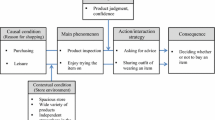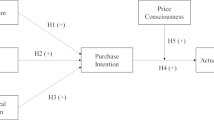Abstract
Using theory of the security process and the concept of choice-structuring properties as heuristic devices, this article develops a conceptual framework designed to aid our understanding of the factors that drive security consumption within the context of small shops. The conceptual framework is developed through a number of exploratory interviews with the owners of convenience stores. These suggest that a security consumption culture exists that is generated by a desire to protect businesses from crime threats and a sense of isolation from local criminal justice agencies. A self-protection mentality and functional form of worry is observed that creates demand for security, but decisions to purchase specific security objects are dictated by choice-structuring properties focused around subjective anxieties about crime events, the extent to which security devices are seen to offer reassurance, and financial constraints. Of course, these findings are (at best) tentative but help to set an agenda for further research in this area.


Similar content being viewed by others
Notes
This is a crude measure as the BRC is a head office survey. The figures include capital and revenue expenditure. Due to the way data are presented in the BRC surveys, the figure for 1992 was derived by dividing the total spend (£370 million) by the number of outlets covered in the survey (34 341). The average was £9280 in 1992/1993 and £13 950 in 2009/2009.
Gill and Howell’s (2012) overview of the security sector is an excellent contemporary overview of the supply side of the security industry in the United Kingdom.
This research was financed through a University of Leicester College grant.
Although it has been widely acknowledged that for many expressive offences (such as a pub brawl) or crimes where alcohol and drugs may be facilitators, the concept of rationality might be questioned (see Haywood, 2007).
Nationally, around 48 per cent of all UK convenience stores are run by Asian or British Asian proprietors (ACS, 2012). Department for Business Innovation and Skills (BIS) (2012) statistics suggest that convenience stores comprise around 10 per cent of the retail sector (50 000 of 515 000 businesses).
It should be noted that strict comparisons cannot be made, as the CVS records shoplifting against the retail and wholesale sector, and therefore the actual figure for the retail sector alone cannot be ascertained.
For example, around 10 per cent of retail/wholesale businesses sampled in the 2012 Commercial Victimisation Survey experienced assaults or threats.
In most businesses, some form of security had been present when the current owner took over the business. In these cases, respondents were asked why they continued to use these forms of security when they took over the businesses.
Alarms were also part of an insurance requirement for two businesses.
Although it might be thought that such measures are commonly installed as direct responses to the types of crime observed in these businesses, no respondents said that the measures were installed as a direct response to a specific crime incident.
Under the 2003 Licensing Act, CCTV can be a condition of granting a licence to sell alcohol. This was not suggested as a reason for the installation of CCTV by any of the sample businesses.
In addition, it could also capture other events such as a customer trying to stage a fake accident in the shop (such as slipping on the floor) in order to make a claim against the owner.
It should be noted that the findings from the 2012 BRC ‘Retail Crime Costs’ survey suggest that crime against retailers could be increasing (see BRC, 2013).
This shopkeeper lived in a neighbouring community and died after being the victim of a robbery.
Whereas dysfunctional worry leads to people withdrawing or disengaging from normal routine daily activities and this erodes well-being and quality of life.
That said, some respondents did give examples of business owners who had considered selling the business as a result of crime victimisation or fear of victimisation; in such cases functional worry had become dysfunctional worry. For example, one respondent pointed to an article that appeared in the magazine Asian Trader in October 2012 that reported on a shopkeeper who was traumatised after a robbery. Here the victim of the attack was too frightened to continue trading and had expressed a desire to sell his business.
References
Asian Trader. (2012) My terrifying gunpoint ordeal has changed me as a person. 20 September, 26(674).
Association of Convenience Stores (ACS). (2012) The Local Shop Report 2012. London: ACS.
Bamfield, J.A.N. (2012) Shopping and Crime. Basingstoke, UK: Palgrave Macmillan.
Barnard-Wills, D. and Wells, H. (2012) Surveillance, technology and the everyday. Criminology & Criminal Justice 12 (3): 227–237.
Beck, A. and Peacock, C. (2009) New Loss Prevention: Redefining Shrinkage Management. Basingstoke, UK: Palgrave Macmillan.
British Retail Consortium. (2009) Retail Crime Costs Survey 2008/09. London: BRC.
British Retail Consortium. (2013) Retail Crime Costs Survey 2011/12. London: BRC.
Burrows, J. and Hopkins, M. (2005) Business and crime. In: N. Tilley (ed.) Handbook of Crime Prevention and Community Safety. Cullompton, UK: Willan, pp. 468–515.
Burrows, J. and Speed, M. (1994) Retail Crime Costs Survey 1994. London: BRC.
Carroll, J. and Weaver, F. (1986) Shoplifters perceptions of crime opportunities: A Process tracing study. In: D.B. Cornish and R.V. Clarke (eds.) The Reasoning Criminal: Rational Choice Perspectives on Offending. New York: Springer-Verlag, pp. 19–38.
Cornish, D.B. and Clarke, R.V. (1986) The Reasoning Criminal: Rational Choice Perspectives on Offending. New York: Springer-Verlag.
Corrigan, P. (1997) The Sociology of Consumption: An Introduction. London: Sage.
Department for Business Innovation and Skills (BIS). (2012) Business Population Estimates for the UK and Regions 2012, https://www.gov.uk/government/uploads/system/uploads/ attachment_data/file/80247/bpe-2012-stats-release-4.pdf, accessed 23 May 2013.
Ekblom, P. and Simon, F. (1988) Crime and Racial Harassment in Asian-Run Small Shops. Police Research Group Crime Prevention Paper Series no.15. London: Home Office.
Farrell, G., Tseloni, A., Mailley, J. and Tilley, N. (2011) The crime drop and the security hypothesis. Journal of Research in Crime and Delinquency 48 (2): 147–175.
Feeney, F. (1986) Robbers as decision-makers. In: D.B. Cornish and R.V. Clarke (eds.) The Reasoning Criminal: Rational Choice Perspectives on Offending. New York: Springer-Verlag, pp. 53–72.
Fine, B. (2013) Consumption matters. Ephemera 13 (2): 217–248.
Garland, D. (2001) The Culture of Control: Crime and Social Order in Contemporary Society. Chicago, IL: University of Chicago Press.
Giddens, A. (1990) The Consequences of Modernity. Cambridge, UK: Polity Press.
Gill, M. (ed.) (2006) Handbook of Security. Basingstoke, UK: Palgrave Macmillan.
Gill, M., Howell, C., Mawby, R.I. and Pease, K. (2012) The Security Sector in Perspective. Leicester, UK: Perpetuity Group.
Goddard, T. (2012) Post-welfarist risk managers? Risk, crime prevention and the responsibilization of community-based organizations. Theoretical Criminology 16 (3): 347–363.
Goold, B., Loader, I. and Thumala, A. (2010) Consuming security? Tools for a sociology of security consumption. Theoretical Criminology 14 (1): 3–30.
Greggo, A. and Kresevich, M. (2011) Retail Security and Loss Prevention Solutions. Boca Raton, FL: Auerbach Publications.
Hayes, R. (2007) Retail Security and Loss Prevention. 2nd edn. Basingstoke, UK: Palgrave Macmillan.
Haywood, K. (2007) Situational crime prevention and its discontents: Rational choice theory versus the ‘culture of now’. Social Policy and Administration 41 (3): 232–250.
Haywood, K. (2012) A response to Farrell. Social Policy and Administration 46 (1): 21–24.
Home Office. (2013) Crime against Business: Headline Findings from the 2012 Commercial Victimisation Survey. London: Home Office.
Hope, T. (2000) Inequality and the clubbing of private security. In: T. Hope and R. Sparkes (eds.) Crime Risk and Insecurity. London and New York: Routledge, pp. 83–106.
Jackson, J. (2011) Revisiting risk sensitivity in the fear of crime. Journal of Research in Crime and Delinquency Risk Sensitivity in the Fear of Crime 48 (4): 513–537.
Jackson, J. and Gray, E. (2010) Functional fear and public insecurities about crime. British Journal of Criminology 50 (1): 1–22.
Jones, T. (2012) Governing security: Pluralization, privatization, and polarization in crime control and policing. In: M. Maguire, M. Morgan and R. Reiner (eds.) The Oxford Handbook of Criminology. 5th edn. Oxford: Oxford University Press, pp. 741–768.
Krahman, E. (2008) The Commodification of Security in the Risk Society. Working Paper 06–08. Bristol: University of Bristol.
Leicester City Council. (2012) Ward Profiles, b1109vol1.pdf, http://www.saferleicester.org/news-info/crime-statistics-for-your-area/westcotes-ward/, accessed 31 May.
Loader, I. (2009) Ice cream and incarceration: On appetites for security and punishment. Punishment & Society 11 (2): 241–257.
Macpherson, J. (2009) Guest editorial: Security manned guarding and the hidden outcomes of the UK’s opt-outs from the EU’s maximum working week legislation. Journal of Retail & Leisure Property 8 (2): 77–78.
Mirrlees-Black, C. and Ross, A. (1994) Crime against Retail and Manufacturing Premises: Findings from the 1994 Commercial Victimisation Survey. London: Home Office Research Study 146.
Molotch, H. (2004) Where Stuff Comes from. London: Routledge.
Manunta, G. and Manunta, R. (2006) Theorizing about security. In: M. Gill (ed.) The Handbook of Security. Basingstoke, UK: Palgrave Macmillan, pp. 629–657.
Natarajan, M. (2012) A rational choice perspective of organized crime and trafficked goods. In: N. Tilley and G. Farrell (eds.) The Reasoning Criminologist: Essays in Honour of Ronald V Clarke. London: Routledge, pp. 194–204.
Office for National Statistics. (2012) Population and households estimates for England and Wales, March 2011. http://www.ons.gov.uk/ons/dcp171778_270487.pdf, accessed 23 May 2013.
Ruighaver, A., Maynard, S. and Chang, S. (2007) Organisational security culture: Extending the end-user perspective. Computers & Security 26 (1): 56–62.
Sarre, R. and Prenzler, T. (2011) Private Security and Public Interest: Exploring Private Security Trends and Directions for Reform in the New Era of Plural Policing. Australian Research Council.
Shury, J., Speed, M., Vivian, D., Kuechel, A. and Nicolas, S. (2002) Crime against retail and Manufacturing Premises: Findings From the 2002 Commercial Victimisation Survey. London: Home Office Online Report 37/05.
Spitzer, S. (1987) Security control in capitalist societies: The fetishism of security and secret Thereof. In: J. Lowman, R. Menzies and T. Palys (eds.) Transcarceration: Essays in the Sociology Social Control. Aldershot, Brookfield: Gower, pp. 43–58.
Westerlund, M., Rajala, R. and Rajala, A. (2011) West security service adoption in b2b context: Do clients and providers hold congruent views? European Journal of Management 11 (3): 42–51.
Williams, J.W. (2005) Governability matters: The private policing of economic crime and the challenge of democratic governance. Policing and Society 15 (2): 187–211.
Wood, J. and Shearing, C. (2007) Imagining Security. Cullompton, UK: Willan.
Author information
Authors and Affiliations
Rights and permissions
About this article
Cite this article
Hopkins, M., Fox, G. The choice-structuring properties of security consumption: An exploratory study of security consumption culture within small shops. Secur J 29, 290–305 (2016). https://doi.org/10.1057/sj.2013.28
Published:
Issue Date:
DOI: https://doi.org/10.1057/sj.2013.28




